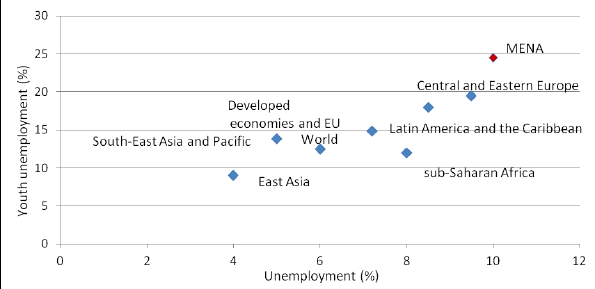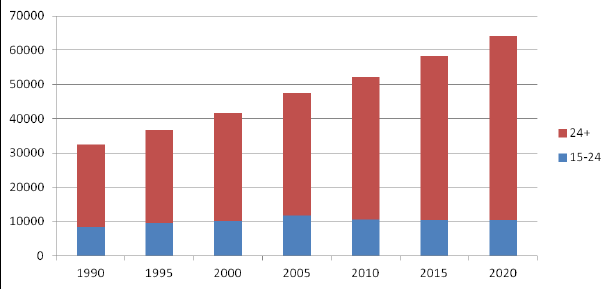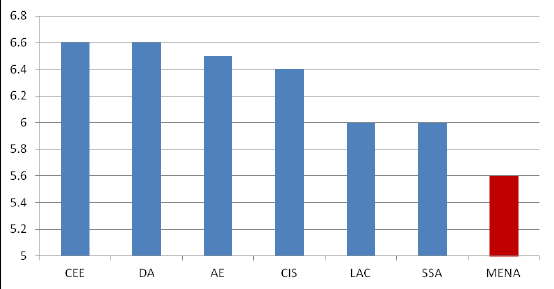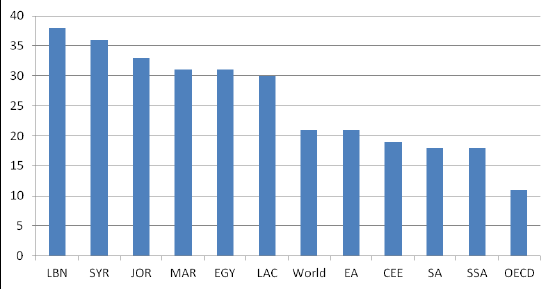Youth Unemployment in the MENA Region: Determinants and Challenges
by Masood Ahmed, Director, Middle East and Central Asia Department, International Monetary Fund; Dominique Guillaume, Deputy Division Chief, International Monetary Fund; Davide Furceri, Economist, International Monetary Fund
Published in the World Economic Forum’s Addressing the 100 Million Youth Challenge—Perspectives on Youth Employment in the Arab World in 2012, June 2012
A Longstanding Urgent Challenge
Addressing high unemployment is a longstanding but increasingly urgent challenge for MENA countries.1 Unemployment in the MENA region is the highest in the world (Figure 1) and largely a youth phenomenon. The share of youth (ages 15 to 24) in total unemployment at least doubles the total rate. Moreover, at about 25%, the youth unemployment rate in the MENA exceeds that of any other region in the world – a rate that reaches up to about 30% in Tunisia (Figure 1). The recent social and political events in the region have contributed to a decline in economic activity and to increased unemployment. In 2011, unemployment has increased in the MENA countries, with the largest increase registered for Tunisia (about 7 percentage points) and Egypt (about 3.5 percentage points).
Unusually, education in this region is not a guarantee against unemployment. In fact, unemployment tends to increase with schooling, exceeding 15% for those with tertiary education in Egypt, Jordan and Tunisia.
In most regions of the world, the duration of unemployment spells is shorter for youth than for adults, reflecting the natural tendency of youth to more frequently move between jobs. In most MENA countries, however, youth unemployment appears to be the result of waiting for the right job. Thus, unemployment spells may be longer, especially for educated youth, who may require more time to find a good job match for their skills. This is an important point, because it is the duration of unemployment, rather than its occurrence, that is most detrimental to human capital accumulation.
Key Factors Behind Youth Unemployment
High labour force growth, skill mismatches, labour and product market rigidities, large public sectors, and high reservation wages have been key factors behind the large and persistent level of youth unemployment.
Demographic Transition
Demographic pressures in MENA might be a leading cause of the high youth unemployment rates in the region. The origins of the current demographic trends began in the 1950s. Over the past 50 years, MENA countries experienced large declines in infant mortality rates. The combination of low infant mortality rates and high fertility rates between 1950 and 1980 led to high population growth rates, which translated into high labour force growth rates from 1970 through 2000 and beyond.
Over the past decade, the labour force in MENA has grown at an average annual rate of 2.7%, faster than in any other region of the world, save Africa. And it will continue to outpace most other regions. The number of labour force entrants remains daunting – approximately 10.7 million new entrants are expected to join the labour force in the coming decade, compared with 10.2 million in the previous decade. However, youth labour force growth is expected to gradually decelerate over the next decade, easing labour market supply (Figure 2). And in some countries, such as Tunisia, the demographic transition will occur even earlier.
Skill Mismatches
Labour market mismatches have been driven by the inability of the economy to create highly skilled work but also by the inappropriate content and delivery of education. Over the past decades, the MENA countries have made important strides in providing education. Average years of schooling (for those 15 years and older) increased four-fold between 1960 and 2000, more than any other region in the world. In 1999, average years of schooling in MENA was 5.3 years, ahead of South Asia (4.6 years) and Sub-Saharan Africa (3.5 years), and only one year behind East Asia (6.6 years) and Latin America and the Caribbean (6.4 years). With respect to illiteracy rates, however, the MENA region still lags behind other regions of the world. In addition, entrepreneurs regularly cite the lack of suitable skills as an important constraint to hiring (Figure 3), and unemployment rates are highest among the most educated. Taken together, this suggests that education systems in the region fail to produce graduates with needed skills.
Labour Market Rigidities
According to the Global Competitiveness Report 2011-2012, hiring and firing regulations in most MENA countries are more restrictive than those in the average emerging and developing country. Similarly, data from enterprise surveys indicates that, worldwide, the percentage of firms identifying labour regulation as a major constraint to their business operations is, on average, greatest in MENA. In addition, indicators of labour market flexibility show that such rigidities are particularly high in MENA (Figure 4) and could significantly limit employment creation, particularly for first-time job seekers, by discouraging firms from expanding employment in response to favourable changes in the economic climate.
Large Public Sectors
The MENA region also has the highest central government wage bill in the world (as a percentage of GDP) – 9.8% of GDP compared to a global average of 5.4%. The high wage bill partly reflects the fact that government employment in MENA is comparatively high, but it also reflects the fact that public sector wages in MENA were on average 30% higher than private sector wages, compared to 20% lower worldwide. Around the turn of this century, the public sector accounted for about one-third of total employment in Syria, 22% in Tunisia, and about 35% in Jordan and Egypt.
Public-sector employment shares are even higher as a percentage of nonagricultural employment – reaching 42% in Jordan and 70% in Egypt. The dominant role of the public sector as employer throughout MENA has distorted labour market outcomes and diverted resources away from a potentially more dynamic private sector. Government hiring practices have typically inflated wage expectations and placed a premium on diplomas over actual skills, influencing educational choices and contributing to skill mismatches.
High Reservation Wages
The comparatively greater job security, higher wages, and more generous on-wage benefits offered by the public sector have inflated wage expectations among new entrants. In fact, public sector wages are 48% and 36% higher than those offered by the private sector in Egypt and Tunisia, respectively. Relatively high wages and benefits encourage workers to seek jobs in the public sector instead of potentially more productive jobs in the private sector.
In addition, generous childcare and maternity leave policies encourage females to focus on obtaining public sector jobs. However, public sector jobs remain valued because of job security, high compensation and benefits, and lack of opportunities in the private sector. It appears that the system essentially has created a dual labour market, with the public sector representing the high-wage, high-benefit sector.
MENA Oil Importers Need to Increase Employment
To absorb the unemployed and new entrants to the labour force, the MENA oil importers will need to increase employment by an estimated 18.5 million2 full-time positions over the next decade – although even this would leave the ratio of employment to working-age population lower than that currently observed in any other region.
Reaching the job target will require a combination of permanently higher economic growth and reforms to improve the responsiveness of the labour market. The fact that youth unemployment has remained high for so long indicates that the problem is largely structural and will not be resolved by a cyclical increase in output, but would need a sustained high and job-creating growth, supported by a sound macroeconomic environment.
A higher growth performance will be necessary but not sufficient to significantly reduce unemployment over the medium term. In particular, in the absence of structural reforms aimed at improving the responsiveness of labour market conditions to changes in economic activity, higher economic growth is likely to have only a modest impact on youth unemployment. In this context, deepening structural policies such as:
• Improving the flexibility of the labour market will be essential to increase labour demand over the medium term and to facilitate the integration of young outsider workers into the labour market. In this context, reforms aimed at reducing search and hiring costs will be crucial.
• Improving the business climate and fostering product market competition will also be key to reducing unemployment over the medium term. In particular, lower barriers to entry curb market power and incumbents’ rents, and they tend to reduce wage claims and close the gap between productivity and real wages. Moreover, stronger competition may reduce bargaining positions of employers and increase employment costs for higher wages. Reduced rent sharing would also decrease the time spent searching for employment opportunities in high-wage sectors. In addition, improvement in business climate and product market competition will also be essential to raising potential growth over the medium term.
• Addressing skill mismatches will be key to reducing youth unemployment. In this context, realigning curricula with private-sector needs, reforming university admission policies and improving the quality of educational systems will be of crucial importance.
• Improving public-sector hiring practices and compensation policies. Public sector hiring procedures should place greater emphasis on skills and competition and less on paper qualifications. Moreover, strengthening the link between compensation and performance and implementing merit-based promotion policies would also send the right signals regarding skill formation for young people.
• Reducing the size of public sector. Large government sectors tend to crowd out private investment and to reduce the size of the private sector and sustained growth over the medium term. In addition, large government sectors often involve higher taxes, which can have depressive effects on aggregate demand and on the labour market.
Ongoing Social and Political Turmoil
The ongoing social and political turmoil in the region has created urgency to start implementing measures in the short term that would also have long-term benefits.
Turn Infrastructure Investment into a Vehicle for Employment Generation
Investment in infrastructure can have a sizable impact on employment generation, even in the short term. For example, evidence from Latin America and the Caribbean suggests that about 40,000 annual direct and indirect new jobs can be created in the short term for every US$1 billion spent on infrastructure projects. Extrapolating these numbers to Egypt and Tunisia, for instance, suggests that 1% of GDP spent on infrastructure could generate in the short term as many as 87,000 new jobs in Egypt and 18,000 jobs in Tunisia. To have an immediate effect, policymakers in the region can therefore seek to bring forward viable labour intensive infrastructure projects that are already in the pipeline, while maintaining fiscal sustainability. Such a policy will not only provide wage employment – including for young people – but will also enhance long-term growth, thereby leading to sustained job creation.
Support Private-Sector Activity through Macro Policies
To encourage job creation, policy-makers can explore the possibility of giving tax incentives or providing credit guarantees to viable labour intensive small and medium enterprises, as was done in many emerging markets and transition economies during the global financial crisis. Moreover, removing impediments to access to credit would also help these enterprises.
Scale up Promising Training Programmes based on Past Successes in the Region
The region offers a growing range of promising youth-oriented training programmes. One such example is the Education For Employment Foundation (EFE), which currently operates in several countries in the region, including Egypt, Jordan and Morocco. EFE works with corporations and industries to assess demand for skills and to provide corresponding tailored training programmes for young people. Through both in-class and on-the-job training, EFE has proven successful in providing job seekers with skills relevant to businesses and placing unemployed youth in jobs. For example, 85% of programme graduates were placed in jobs in Jordan and 86% were placed in jobs and internships in Morocco. Policy-makers should seek to scale up and replicate such promising programmes.
Introduce New Well-Designed and Effective Training Programmes
Given the magnitude of youth unemployment and the urgent need to address it, policymakers may want to initiate new investments in well-designed training programmes, in addition to expanding training programmes that have shown some success. It is crucial that policymakers act now, given that it may take some time to reap the benefits of new investments. Some lessons can be learned from the experiences of other countries when designing such programmes. For example, evaluations of youth training programmes in Latin America indicate that those that are demand-driven, offer on-the-job training, focus on both hard- and soft-skill formation, monitor performance and perform impact evaluation have a significant positive impact on employment and earnings of programme participants.
At the same time, when designing short-term solutions to youth unemployment, governments should ensure that such solutions do not harm the long-term goal of sustainable job creation and productive skill formation. For example, in light of the ongoing political turmoil and uncertainty, governments may be enticed to quickly create unneeded jobs in the already large public sector. Such a policy, which may be difficult to unwind later, may distort labour market incentives and divert resources away from a potentially more vibrant private sector. As another example, giving subsidies to the educated unemployed youth, while well-intended and providing relief, may reinforce skills mismatches for future labour market entrants if the qualification for such subsidies is based solely on diplomas and credentials.
Turning the Labour Force into an Asset
In sum, the key to successfully addressing the formidable youth unemployment challenge in MENA oil-importing countries is to turn the large and growing labour force into an asset, rather than a constraint. This will require ensuring sustained, high, and job-intensive growth, refocusing education and training to reduce skills mismatches, enhancing labour market flexibility and maintaining macroeconomic stability.






